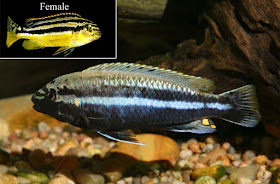Atlantic Trumpetfish (Aulostomus maculatus)
The Atlantic Trumpetfish or Aulostomus maculatus is a saltwater fish found in and around reefs in the Atlantic Ocean. These fish are masters of camouflage, using their long slender bodies to mimic gorgonians, sea whips and sea weeds. They lie in wait with their nose facing the sea floor until a small fish or shrimp swims too close sucking them up in its tube shaped mouth! They are also known to shadow on top of herbivorous fish to get close enough to other smaller fish without being noticed. Very tricky predators!
The Atlantic Trumpetfish is a close relative of the Seahorse and Pipefish and gets it name from it trumpet-shaped snout. They are able to change their coloration at will although three basic colour schemes exist: reddish brown, gray with a blue snout, and yellow. Growing to about 3' (1 meter) they will feed on shrimp, Grunts, Wrasses, Chromis and Soldierfish. This species of Trumpetfish will fall prey to Jacks, Snapper, Grouper and sharks. You can check out the Atlantic Trumpetfish swimming in the video below.
If you have any additional information about the Atlantic Trumpetfish please leave us a comment below.
Auratus Cichlid (Melanochromis auratus)
The Auratus Cichlid or Melanochromis auratus is a freshwater fish from Lake Malawi in Africa. Also known as the Malawi Golden Cichlid, this fish is born a bright yellow color with the juveniles having two black stripes on their sides, and one on their dorsal fin. As the fish begins to mature these lines will turn more blue. The males of this species will become black with golden stripes, almost the opposite of their female counterparts.
Auratus Cichlid are often kept in an aquarium setting, but need a lot of room and they can be quite aggressive. They will accept most aquarium foods and are considered to be quite hardy.
This species of Cichlid is a maternal mouthbrooder, which means that the mother will actually keep the baby fish in her mouth protecting them from potential predators. The fry will occasionally come out of the mouth, but still stay close to the mother just in case they need to run back in. This occurs for a period of about 4 weeks. You can see this mouth brooding in action in the video below.
If you have any additional information about the Auratus Cichlid please leave us a comment below.








